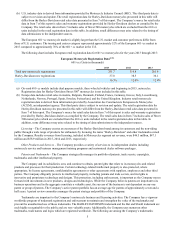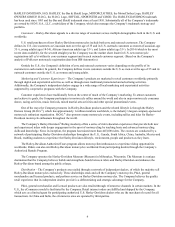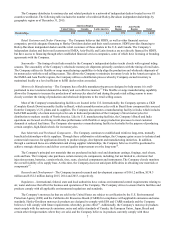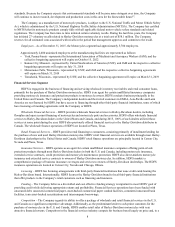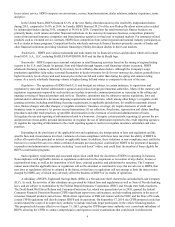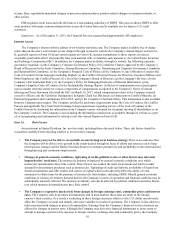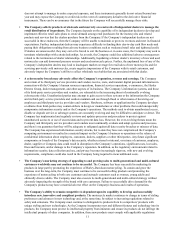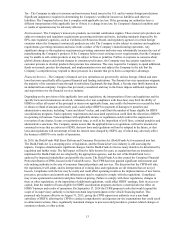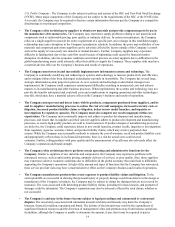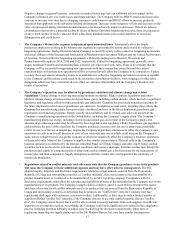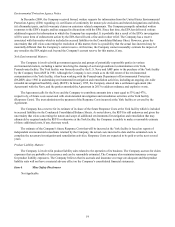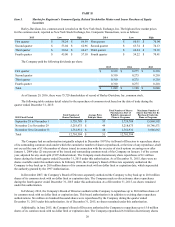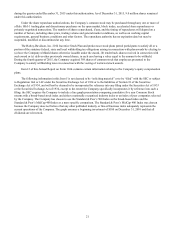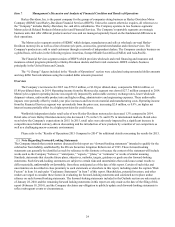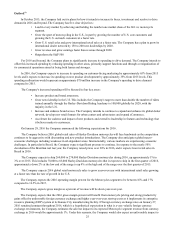Harley Davidson 2015 Annual Report Download - page 15
Download and view the complete annual report
Please find page 15 of the 2015 Harley Davidson annual report below. You can navigate through the pages in the report by either clicking on the pages listed below, or by using the keyword search tool below to find specific information within the annual report.15
connection with the resolution of the lawsuits by settlement or otherwise, any such payment may have a material
adverse effect on the Company’s business and results of operations. Refer to the Company’s disclosures concerning
legal proceedings in the periodic reports that the Company files with the Securities and Exchange Commission (SEC)
for additional detail regarding lawsuits and other claims against the Company.
• The Company’s success depends upon the continued strength of the Harley-Davidson brand. The Company
believes that the Harley-Davidson brand has significantly contributed to the success of its business and that
maintaining and enhancing the brand is critical to expanding its customer base. Failure to protect the brand from
infringers or to grow the value of the Harley-Davidson brand may have a material adverse effect on the Company’s
business and results of operations.
• The Company must maintain stakeholder confidence in its operating ethics and corporate governance
practices. The Company believes it has a history of good corporate governance. Prior to the enactment of the
Sarbanes-Oxley Act of 2002, the Company had in place many of the corporate governance procedures and processes
now mandated by the Sarbanes-Oxley Act and related rules and regulations, such as Board Committee Charters and a
Corporate Governance Policy. In 1992, the Company established a Code of Business Conduct that defines how
employees interact with various Company stakeholders and addresses issues such as confidentiality, conflict of interest
and fair dealing. Failure to maintain its reputation for good corporate governance may have a material adverse effect
on the Company’s business and results of operations.
• The Company may not be able to successfully execute its manufacturing strategy. The Company’s manufacturing
strategy is designed to continuously improve product quality and increase productivity, while reducing costs and
increasing flexibility to respond to ongoing changes in the marketplace. The Company believes flexible
manufacturing, including flexible supply chains and flexible labor agreements, is the key element to enable
improvements in the Company’s ability to respond to customers in a cost effective manner. To execute this strategy,
the Company must be successful in its continuous improvement efforts which are dependent on the involvement of
management, production employees and suppliers. Any inability to achieve these objectives could adversely impact
the profitability of the Company’s products and its ability to deliver the right product at the right time to the customer.
• The Company, its suppliers, and its independent dealers must successfully accommodate a seasonal retail
motorcycle sales pattern. The Company records the wholesale sale of a motorcycle when it is shipped to the
Company’s independent dealers. The Company's flexible production capability allows it to more closely correlate
motorcycle production and wholesale shipments with the retail selling season. Any difficulties in executing flexible
production could result in lost production or sales. The Company, its suppliers, and its independent dealers must be
able to successfully manage changes in production rates, inventory levels and other business processes associated with
flexible production. Failure by the Company, its suppliers, or its independent dealers to make such adjustments may
have a material adverse effect on the Company’s business and results of operations.
• The Company incurs substantial costs with respect to employee pension and healthcare benefits. The Company’s
cash funding requirements and its estimates of liabilities and expenses for pensions and healthcare benefits for both
active and retired employees are based on several factors that are outside the Company’s control. These factors include
funding requirements of the Pension Protection Act of 2006, the rate used to discount the future estimated liability, the
rate of return on plan assets, current and projected healthcare costs, healthcare reform or legislation, retirement age
and mortality. Changes in these factors can impact the expense, liabilities and cash requirements associated with these
benefits which could have a material adverse effect on future results of operations, liquidity or shareholders’ equity. In
addition, costs associated with these benefits put the Company under significant cost pressure as compared to its
competitors that may not bear the costs of similar benefit plans. Furthermore, costs associated with complying with the
Patient Protection and Affordable Care Act may produce additional cost pressure on the Company and its health care
plans.
• The ability of the Company to expand international sales may be impacted by existing or new laws and
regulations that impose motorcycle licensing restrictions and limit access to roads and highways. Expanding
international sales is a part of the Company’s long-term business strategy. A number of countries have tiered
motorcycle licensing requirements that limit the ability of new and younger riders to obtain licenses to operate the
Company’s motorcycles, and many countries are considering the implementation of such requirements. These
requirements only allow new and/or younger riders to operate smaller motorcycles for certain periods of time. Riders
typically are only permitted to obtain a license to ride larger motorcycles upon reaching certain ages and/or having
been licensed to ride smaller motorcycles for a certain period of time, and only after passing additional tests and
paying additional fees. These requirements pose obstacles to large displacement motorcycle ownership. Other


